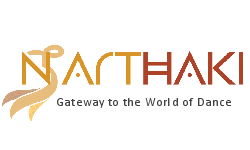
|   |

|   |
Odissi Odyssey: A Multimodal Framework for Community Engagement, Pedagogy, and Interdisciplinary Collaboration in Indian Classical Arts - Dr. Rohini Dandavate e-mail: dandavate2@gmail.com May 10, 2025  Odissi Odyssey Conference on May 3 and 4 at UNC, Charlotte Community engagement through the arts offers a unique and inclusive pathway for fostering dialogue, cultural exchange, and long-term societal transformation. When applied to traditional art forms such as Indian classical dance, this engagement can serve as a bridge between generations, disciplines, and geographies. Odissi Odyssey curated by Dr. Kaustavi Sarkar, Associate Professor in the Department of Dance at the University of North Carolina at Charlotte, exemplifies such an effort. Positioned at the intersection of pedagogy, performance, and scholarship, the project brought together a diverse network of dancers, educators, musicians, and researchers from across North America and India to explore the evolving role of Indian classical arts in a global context. The structure of Odissi Odyssey reflected a deliberate effort to create an environment in which traditional dance practices could be taught, performed, and critically examined. Central to the initiative was a pedagogical framework that guided instructors in mentoring students across multiple classical Indian dance styles. Over a period of six months, participants engaged in sustained training and preparation, culminating in a large-scale weekend exposition. This event featured approximately 200 students and their mentors presenting works in all eight recognized classical dance forms of India. These performances ranged from solo and duet presentations to ensemble pieces, and included participants as young as four years old. The age and background diversity of the performers underscored the accessibility of the initiative and its emphasis on inclusivity. Choreographies presented during the exposition were rooted in scriptural verses and folk narratives drawn from India's vast literary and oral traditions and some innovative works too. In this way, the performances not only showcased technical proficiency but also engaged with storytelling as a cultural and educational tool. Audiences experienced the continuity of Indian aesthetic traditions through the lens of diasporic practice, where classical forms were interpreted and reimagined in a North American context. A distinguishing feature of Odissi Odyssey was its musical experimentation. Indian vocalists and instrumentalists collaborated with Western musicians to create innovative sonic landscapes that pushed the boundaries of Hindustani music. These intercultural collaborations added another layer of complexity and richness to the performances, offering a fresh perspective on how classical Indian arts can adapt and thrive in contemporary artistic spaces. Beyond performance, the initiative incorporated a strong research component. Graduate students and independent scholars from institutions including The Ohio State University, New York University, the University of California, Riverside, and UNC Charlotte presented their work in sessions designed for peer review and critique. These presentations focused on topics such as dance-making processes, Indian dance pedagogy, and issues of representation and authenticity in diasporic practice. The academic exchange fostered an environment where practice and theory could inform one another, encouraging a deeper understanding of the cultural, pedagogical, and creative dimensions of Indian classical arts. Over the course of two days, Odissi Odyssey offered audiences not only performances but also access to the artistic philosophies of legendary Gurus and the unique textures of three major Indian music systems: Carnatic, Odissi, and Hindustani. These traditions were brought to life by distinguished vocalists from both India and North Carolina, reinforcing the project's goal of connecting local and global artistic communities. The participant Danc(N)Community Guides who presented their students were:
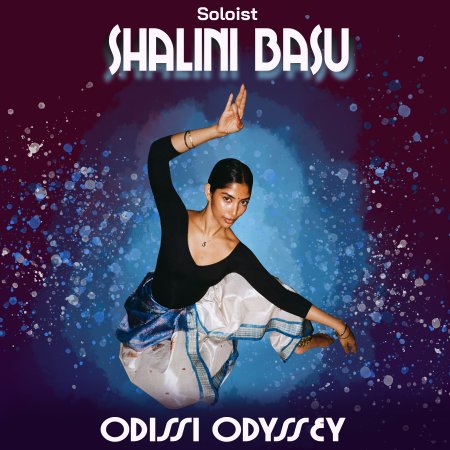 Soloist Shalini Basu also served as Assistant Conference Coordinator for Odissi Odyssey Drawing from the choreographic legacies of senior Gurus, the dance presentations in Odissi Odyssey reflected both the depth of traditional Odissi styles and the dynamism of evolving movement vocabularies. These performances offered audiences a compelling glimpse into the creative lineage of legendary masters as well as the innovative visions of contemporary choreographers and teachers. Pieces choreographed by leading practitioners showcased a nuanced interplay between historical continuity and modern reinterpretation, revealing Odissi's adaptability and expressive potential in today's globalized artistic landscape. In the afternoons, the conference transitioned into scholarly presentations that extended the artistic inquiry into critical and conceptual terrain. Among these was a collaborative presentation by Sri Thina Subramanium and Malavika Singh, who explored the poetry of Rupi Kaur to examine themes of self-completeness, empowerment, and the complexities of feminine experience. Their work wove literary and movement-based narratives to reflect contemporary feminist discourse within Indian aesthetics. Debabrata Pal contributed an interdisciplinary perspective by integrating Indian dance movements into visual art. His practice-based research demonstrated how gesture and form from classical dance could be transposed into the visual medium, creating a synthesis of kinetic and static expression. NYU graduate Shalini Basu examined themes of desire, deception, and longing through her analysis of An Impossible Romance, a choreographic work by Dr. Maya Kulkarni. Her presentation highlighted the ephemeral nature of romantic idealism as explored through Indian classical vocabulary. Amara Kranz, an undergraduate student in the Department of Dance at UNC Charlotte, presented Straight, a contemporary piece that used the metaphor of the liberated dancing body to question conformity and stagnation in thought and action. The choreography drew on personal and political themes, asserting the body as a site of agency and transformation. 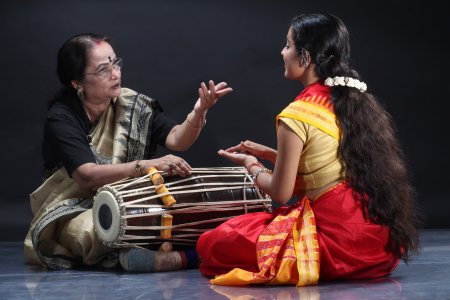 Scholar/ soloist Sriradha Paul (on the right) dedicating this conference to her Guru Poushali Mukherjee who recently passed away Sriradha Pal, a doctoral candidate in Dance Studies at the University of California, Riverside, presented research on “mimetic disruption.” She explored how internet memes, as contemporary cultural texts, challenge and reconfigure traditional power hierarchies embedded in the Guru–Shishya (teacher–disciple) relationship. Her presentation opened provocative questions about authority, tradition, and cultural transmission in the digital age. The evening concerts expanded the festival's interdisciplinary ethos through collaborative and experimental performances. The program opened with Don't Go, Don't Go, a piece performed by Claudio Olivera and Susan Gouthro, with improvisational dance by Dr. Kaustavi Sarkar. This cross-disciplinary collaboration set the tone for a series of performances that blurred boundaries between movement, music, and narrative. The Chamber Glides followed, a collaboration between clarinetist Jessica Lindsey and Charlotte-based artist Amrita Biswas - a multifaceted performer, singer, and educator. Their duet presented a fusion of musical textures and embodied performance that explored stillness, glide, and breath as choreographic devices. Another highlight was Yearning, a deeply emotive work performed by a group of Odissi dancers alongside a musical ensemble led by vocalist Amrita Biswas. This collaboration was accompanied by a diverse ensemble of musicians including James Brock (drums), Mark Catoe (keyboard and clarinet), Rajesh Uttangi (guitar), Srimanta Gupta and Chinmay Kulkarni (tabla), Ashutosh Derasari (flute), and Nelson Rios (bass guitar). The resulting composition was a haunting exploration of longing through rhythm, movement, and melody. The program continued with Colors, another ensemble work, which served as a melodic and movement-based experiment. Drawing from the same musical collaborators, the piece explored the interplay of group vocals and abstract movement to depict emotional and thematic shifts through chromatic symbolism. In Gajar, an experimental work by Dr. Maya Kulkarni, performers Deepa Mahadevan and Shalini Basu delved into the narrative of the Varkaris - a community of spiritual pilgrims in Maharashtra - through a fusion of expressive movement and contemporary composition by Shyam Kalyan. The work highlighted the spiritual intensity and collective energy of pilgrimage as both cultural ritual and metaphor. 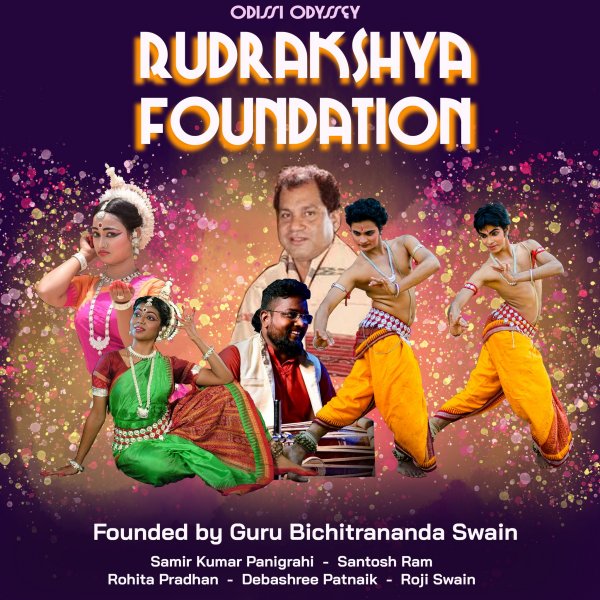 Rudrakshya Foundation was featured ensemble from India A special highlight of the conference was the performance by the renowned Odissi dance company Rudrakshya, based in Bhubaneswar, Odisha. Their repertoire included pieces based on Ram Stuti, Bhavani Bhujangam Stotra, and the devotional hymn Sarva Mangala. These performances paid tribute to the iconic choreographies of Guru Kelucharan Mohapatra and Guru Bichitrananda Swain. The dancers exhibited extraordinary technical precision and expressive clarity, reflecting years of rigorous training and a deep commitment to classical tradition. Their seamless execution and emotive power left a profound impression on the audience. The final evening concluded with contributions from the UNC Charlotte Department of Dance. Choreographer Ashly Tate presented two original works, Discover, performed by Professor Tate herself, and Introspection, performed by student dancers from UNC Charlotte Dance. These pieces reflected themes of self-discovery and inner reflection through fluid contemporary vocabulary. The program concluded with Vitruvian Wo (Man), a collaborative work by Professor Kim Jones and a group of student performers from the Department of Dance, which explored gender, embodiment, and anatomical symmetry through a fusion of dance and visual abstraction. In its totality, Odissi Odyssey emerged as a powerful exemplar of how classical art forms can be adapted to foster inclusive, educational, and interdisciplinary spaces. The initiative revealed the potential of multimodal engagement - through performance, scholarship, and community practice - to revitalize traditional forms while encouraging innovation. As academic institutions increasingly seek to incorporate culturally grounded yet forward-looking programs, Odissi Odyssey offers a compelling blueprint. It affirms that tradition and experimentation are not oppositional, but rather, co-constructive forces that enrich our understanding of artistic heritage and its place in the modern world. 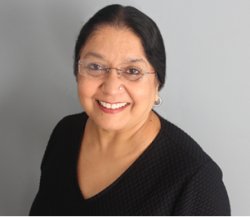 Dr. Rohini Dandavate is a distinguished practitioner of Odissi dance and a scholar in the field of Cultural Policy and Arts Administration, holding a doctorate from The Ohio State University. Dr. Dandavate designs workshops and curricula for educational institutions and community organizations that promote cultural diversity through the lens of traditional arts. Her work serves as a bridge between heritage and contemporary pedagogy. She has produced multimedia resources to support Odissi dance education and authored numerous papers on Odissi, arts administration, cultural policy, and dance education. |